| Preface. I accidentally discovered this webpage of Hennie Henskens te Winkel on the internet, I was looking for information about her father Hendrik Willem Cornelis te Winkel (1903-1985) After reading the story I came up with the idea to "modernize" this page or say "adapt", apart from the written story of Hennie te Winkel of course. Hennie's story has remained intact except for a single word or phrase I have made some adjustments / additions regarding photos and more explanation about specific words and places, which are displayed in Javanese, to give an explanation to / about it so that non former Indian Dutchmen understand what these words mean. I assume that this page does not detract from the original story of Mrs. Henskens, of which I do not even know whether this "lady" is still among us, since there is no information about it, if anyone knows more about Hennie Henskens in Winkel and/or her father "Henk" then I would like to know, thanks in advance.(this fact is now known, read below) |
| Additional information about this story below |
| Some time ago I received an email from a lady named Ellen Gonsalves, who personally knows the author of this remarkable story. I personally expanded the story a bit more but certainly didn't want to detract from the original. I have Mrs. Gonsalves of course wrote an email back that I was surprised, after that I heard nothing more, it's a pity but that's how it goes in this current digital age where everyone is in a hurry and everything has to be faster, preferably even faster than light itself ! But oh well I'm a voice crying in the desert so to speak, and fortunately I was also able to experience the era when there were no computers and no BSN (the former SOFI numbers, yes I am of the year 1953 and was born nine months after the flood) but just wanted to say this, I wish the writer of this story many more years, she is now 90 years old when writing this epistle old! |
"the cake that was left behind" |
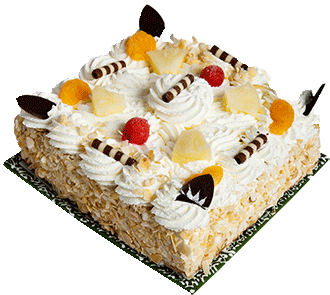 |
Fighting |
| The run-up to our departure to the Netherlands was marked by fights and shelling whereby the arrival in the Netherlands paled. My father, Hendrik Willem Cornelis te Winkel (1903-1985) who had been a prisoner of war in Batavia during the Second World War, had discovered through the Red Cross that my mother and I were imprisoned in Lampersari, Semarang. He took us out with a Betja (see image), thank God it turned out that we had family, all Carli's (my mother's maiden name), in the Villapark, an Old-Indian house with an open front gallery, a garage and a blakang. (is a backyard?) The house stood at a triple jump and we knew that, we were exactly in the line of fire when the street fighting of the pemudas started. I can still see them in a sneaky position, between the djarak trees, with the rifle ready. Bullets pierced two walls of the garage and got stuck in the wall of the back gallery. In the meantime, the two men of the family, including my father, had been lifted from their beds and arrested by Indonesian freedom fighters and thrown nto jail for the sole purpose that you never get out again alive!. My father, a totok * , born in Scheveningen in the Marcelisstraat , spoke fluently Javanese. He knew how to talk himself free, get hold of keys and redeem so many other prisoners. He has received a ribbon for this after the war. |
| * Totok is the Indonesian or Malaysian word for a thoroughbred 'white' European, mostly Dutch, born or living in the former Dutch East Indies. Although the totok was born in India or lived there for a long time, it has no Indonesian ancestors, unlike mixed Indo-Europeans. (Source: Wikipedia) |
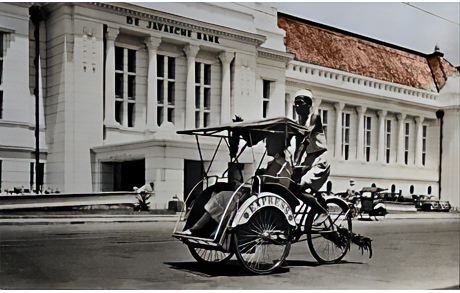 an example of a "Betja" |
| On Saturday, November 17, 1945, our entire family, three mothers with children, a grandmother, a few nieces and the two men, had to flee because of the danger that we were facing. On this same Saturday, November 17, 1945, note my twelfth birthday and my first real birthday after three and a half years of camp time. My first birthday cake was left in the house, I still hear from Carli's aunts: "Remember, Hen, your cake was left in the house." |
 |
| We were received in ' Hotel du Pavillon ' (see image) where Gurkas were sitting to protect the Dutch. There were many fights around the hotel and we children? We watched with interest how the Gurkas slaughter their goats. From there we were evacuated again in lorries, padded with hump bags, which brought us to pilots on the road to Semarang. The mothers must have been worried about their children! about those children? well they just kept playing. There on that 'Roadstead' ( Semarang had no harbor ) I learned that if a gun is fired ( there was a warship on the way ) you first see the fire and only a little later did you hear the bang. With a LTC * and under cannon fire we were sailed to the ship and transported to Batavia. My parents and I ended up in the " Java Hotel " (see image), where my father suggested on the night of Monday December 31, 1945 that there was a mertjoe ( mertjoe = is a kind of firecracker ) was shot to reassure me, because I had become pretty scared of popping. The reality was that shooting was taking place and finally we came to live in a real house on Stillelaan 1, a street with four houses between Tjikini ** (see image) ( not far from the pasar ) and the Alataslaan. |
| * LTC This is probably a sort of Landing vessel, I could not find the abbreviation LTC as such , but an LC (landing-carrier) and LT ( Landing transportship ) |
| ** Tjikini, denotes the hospital, this hospital was on the Tjiliwoeng halfway between Batavia center and Meester Cornelis. Sick and wounded Japanese soldiers were cared here for during the Japanese occupation. The official name of the ' Tjikini ' hospital was the ' Queen Emma Hospital ', the name ' Tjikini 'came from a nearby kampong. |
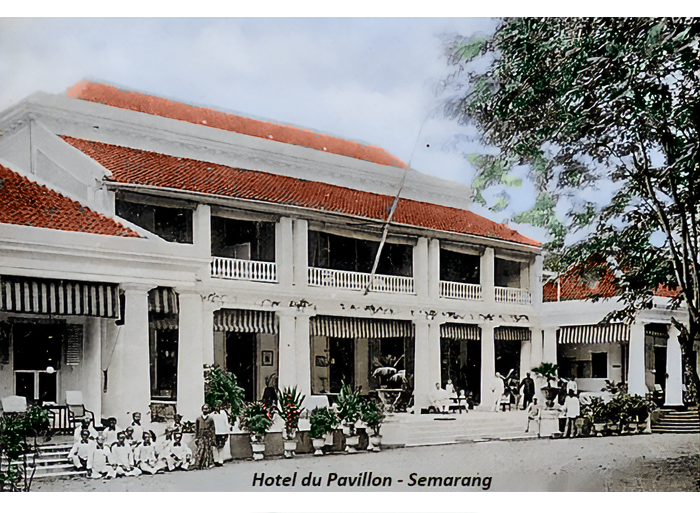 |
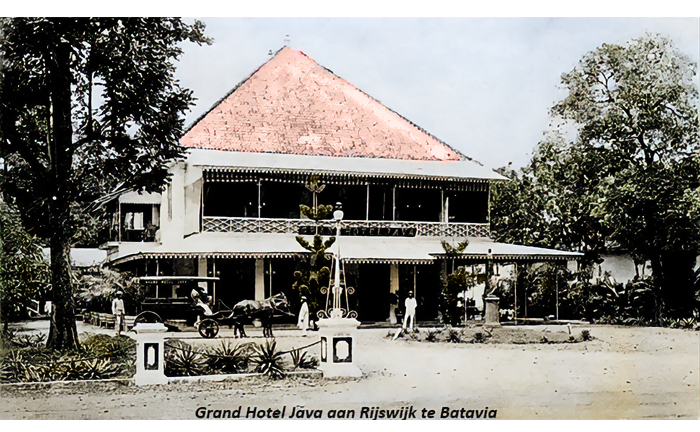 |
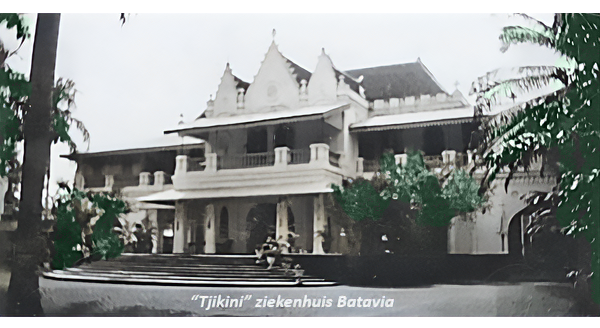 |
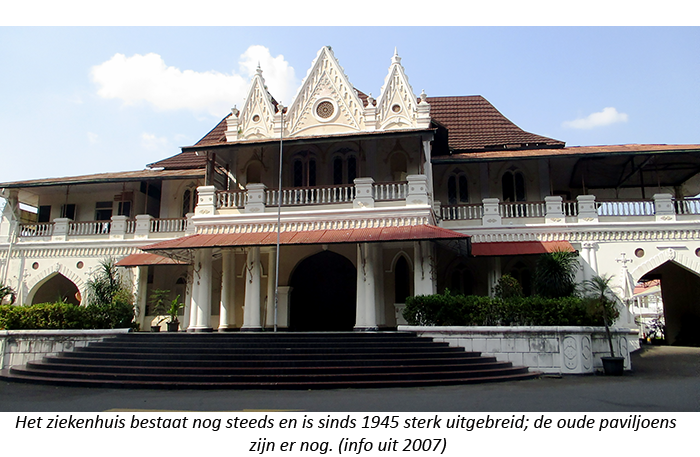 |
| The hospital still exists and has been greatly expanded since 1945, the old pavilions are still there, info from 2007 |
I see what you don't see |
| I spent a lot of time in the military hospital where my pre-war orthopedic surgeon worked and where a small room was reserved for children under the care of this doctor Belmonte. There too, people sometimes shot and fought in the immediate vicinity and yet we had a lot of fun among ourselves. As we walked through the room with men on our way to the mandi room, we shouted ( with eyes down ): " I see, I see what you don't see ", because a lot of "special parts" were washed in that hospital room, about which we 12 and 13 year olds giggled. We children must have been a welcome distraction for many of those men, they taught us cards and dice and they were allowed to write in our poetry album. Finally after several operations I was allowed to go home with my right leg in plaster and finally I could secretly climb over the fence and the wall with the neighbors in the sleep hour to go play "knuckling" (knuckles were play stones) with my neighbor girl Joke Kraak on the gray-green glazed tiles of the front gallery . |
To the Netherlands |
 |
| My mother and I finally arrived in the Netherlands by plane via Singapore, Colombo, Basra, Baghdad, Sjarja, Cairo and Rome on the birthday of the old Queen Wilhelmina, on Sunday 31 August 1947. I thought there were all offices along the way, because there were no gardens. We were lucky that a former friend of my mother, from the Dutch East Indies, took us into her home, so no contract pension for us. I liked everything that came on the table, potato soup and stew; I think I was just hungry. The pea soup did taste very strange, because in the Dutch East Indies it was made from katjang idjoe (Indonesian for mung beans ) And there at that address I was told that my father not would come to the Netherlands, he had met his second wife when he arrived with us in the Betja at the address in the Villapark, Mary Jane Adam (1920-1991). |
| Hennie Henskens te Winkel |
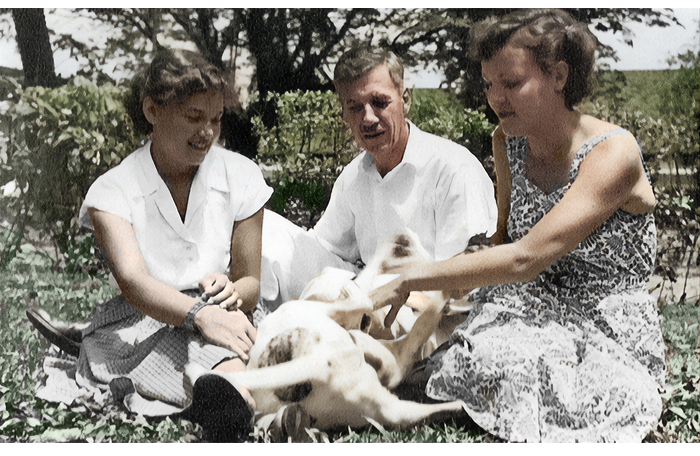 Hennie Henskens te Winkel Hendrik Willem Cornelis te Winkel Mary Jane Adam photo dates from 1952 |
     |
| English translation and editing by the The Ancestor Company All rights reserved, Source: Hennie Henskens te Winkel Thanks to various archive institutions for making certain images and facts available. Copyright © Genealogybos.com 2025 |